As humans, we often forget that other animals create meaningful bonds with one another, just as we do! From the majestic whales of the deep sea to the tiny rodents on land, many of earth’s creatures demonstrate the ability to form strong relationships among their own species. No matter what size they are, animals can form strong bonds with family and friends. These remarkable animals bravely protect their families, displaying their utmost love, loyalty, and devotion time and time again. Here are seven incredible animals that illustrate just how powerful these social connections can be!
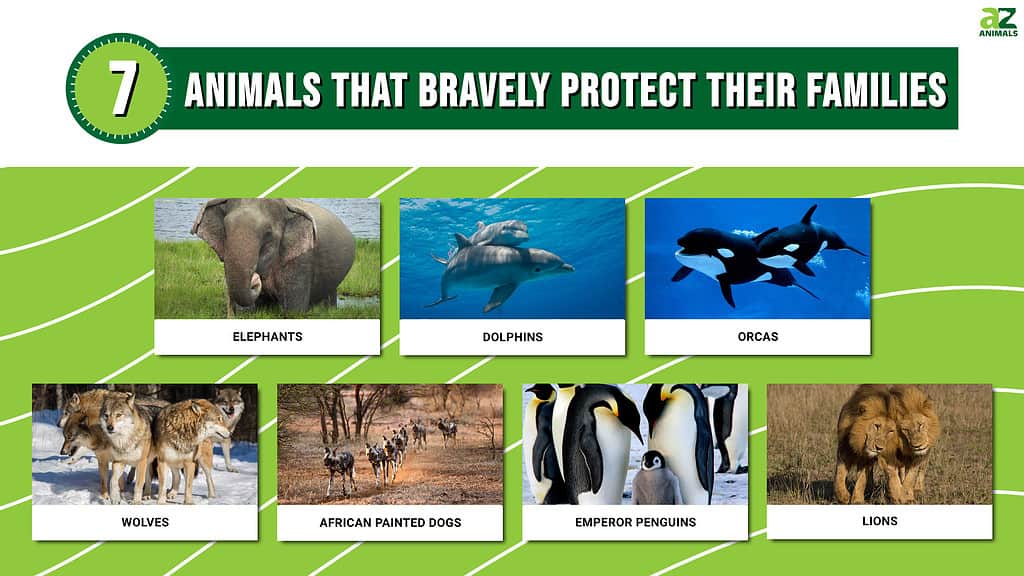
©
Read on for more information about these amazing animals!
1. Elephants
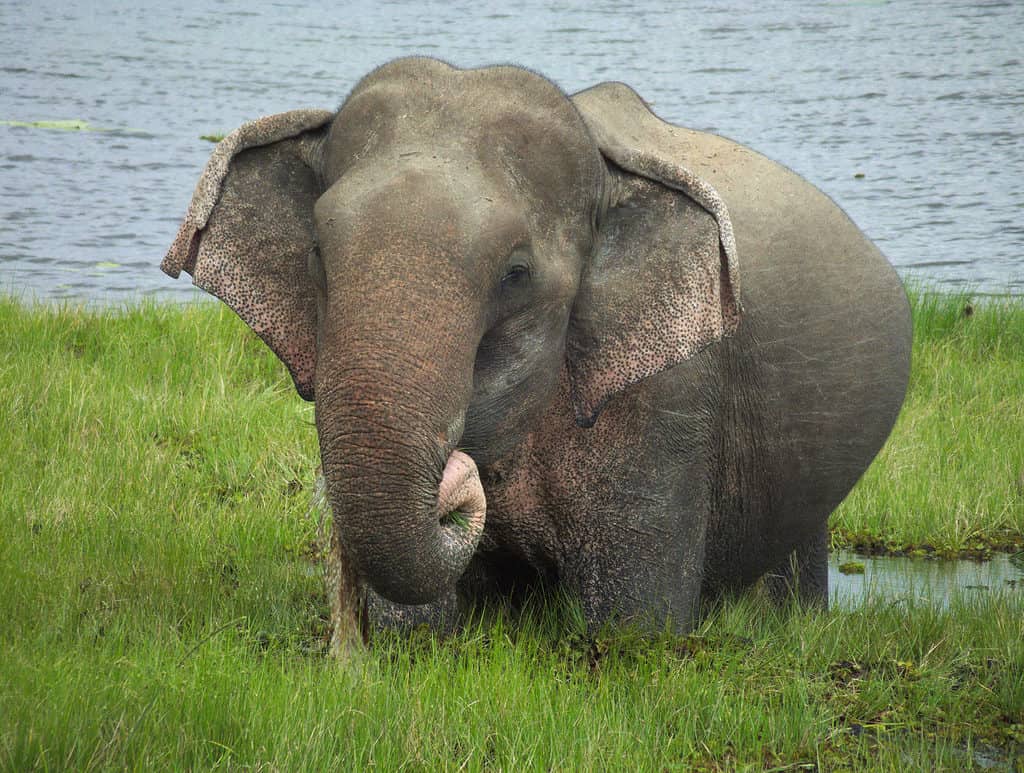
Mother elephants carry their babies in the womb for two whole years!
©iStock.com/Lekamalage
One of the most protective animals on earth is the elephant. Elephants live in large family groups and protect each other through cooperation and communication. They develop strong bonds with their family members, starting before they are even born. Mother elephants carry their babies in the womb for two whole years! Once the baby is born, it is cared for by the entire herd, which is made up of its extended family members, including many adoring aunts. If the mother dies, the herd even steps in and adopts the orphaned elephant, caring for it as if it was their own.
Females travel in large herds and keep their young clustered in the middle of the group so that they can protect them. If a predator tries to attack one of the elephants, the herd is ready to immediately defend their friend. If a baby lags behind, its mother stays by its side to protect it while the herd continues forward.
However, the herd does not abandon the mother or her baby. In fact, when they find water, the elephant herd sends a message to the mother to tell her where they are. Elephants can detect distant vibrations, possibly even more than 100 miles away. So, the herd sends their own unique vibrations with their trunks through the ground, which the mother elephant can pick up through her sensitive feet. Even from afar, elephants will always bravely protect their families!
2. Dolphins

Dolphins use whistles to identify themselves and other family members in their pods.
©iStock.com/NaluPhoto
Living in social groups called pods, dolphins work together to protect their families. Using their unique forms of cooperation and communication, dolphins work together to catch food, defend each other from predators, and raise their young. On occasion, dolphins may even collaborate with other dolphin species to form superpods. In large groups, dolphins can defend each other more easily and intimidate predators that might otherwise try to catch a lone dolphin for a quick meal.
Females with babies form their own groups, often with other female family members, to help each other care for their young. Baby dolphins develop very strong bonds with their mothers and stay with them for many years. Dolphins use whistles to identify themselves and other family members in their pods. When any individual is in danger, it emits a distinct call for help, and the pod members respond immediately, offering help.
3. Orcas

As young orcas grow and mature, they often remain with their family groups throughout their lives, helping to protect and care for one another.
©slowmotiongli/Shutterstock.com
Like dolphins, orcas (or killer whales) stay together in large, intergenerational pods where they work together to protect the family. Although orcas are apex predators, their young are especially vulnerable to other carnivores in the ocean. When there is a threat, older orcas surround the babies and swim in close circles to protect them. As young orcas grow and mature, they often remain with their family groups throughout their lives, helping to protect and care for one another. These bonds allow the orcas to maintain their unique sense of family and community as they traverse the dangers of the ocean.
Older females lead the pods as matriarchs, teaching the younger generations unique fishing techniques, along with the secrets to finding reliable food. Orcas also hunt together and use very strategic and coordinated maneuvers to attack prey. After a successful kill, they commonly share the food with their family members. Orcas communicate and coordinate their behaviors through complex vocalizations. Their calls can travel over miles of ocean, helping orcas to keep track of their families.
4. Wolves
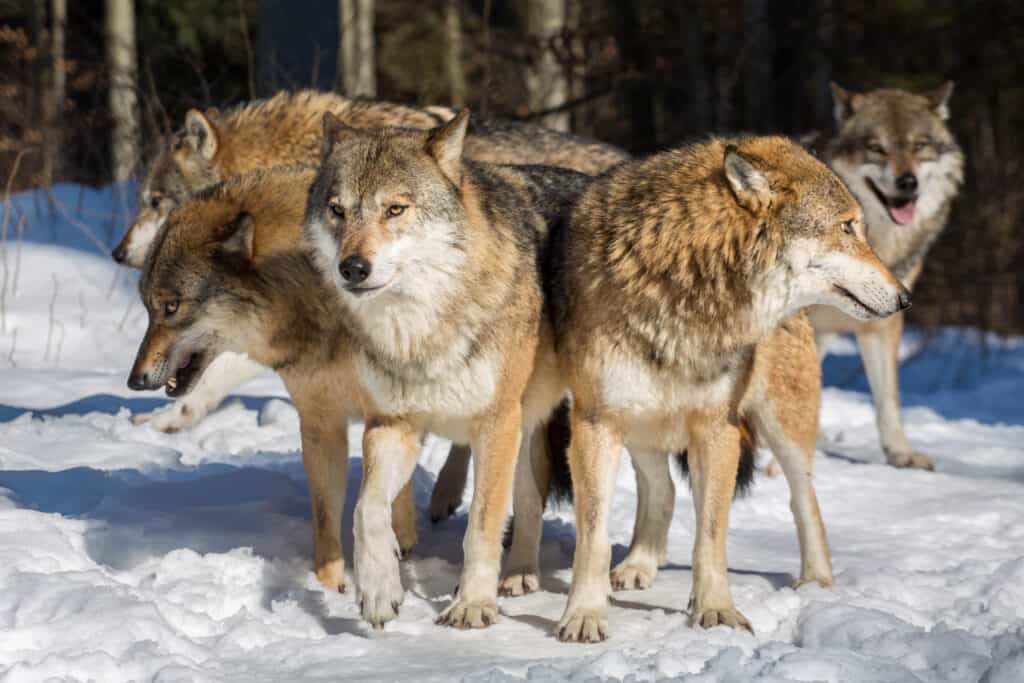
Time and time again, wolves continue to demonstrate their loyalty and unyielding devotion to protecting their families, no matter the cost.
©David Dirga/Shutterstock.com
One of the most iconic animals known for bravely protecting their families is the wolf. Wolves live in highly organized social groups called packs. They are made up of close-knit family members that provide protection for one another. They will fiercely defend themselves and their packs against any predators or rivals, often to the very end. Rick McIntyre from Yellowstone National Park observed this firsthand. He watched a wolf from the Lamar Canyon Pack named Big Grey fight off 12 other wolves from a rival pack, giving his life to protect his pregnant mate and their young pups. In other cases, when mothers are killed, wolves from the rival pack often adopt and care for the abandoned pups as if they were their own!
Jim and Jamie Dutcher, authors of The Wisdom of Wolves: Lessons from the Sawtooth Pack, recount the story of a wolf in Alaska that had suffered from a broken jaw. The jaw was so damaged that the wolf could not hunt or even tear meat from a kill. However, the wolf lived for several years long after this injury. Rather than leave him behind to starve on his own, the wolf’s family brought food to him, often regurgitating it as if he were a young pup. Time and time again, wolves continue to demonstrate their loyalty and unyielding devotion to protecting their families, no matter the cost.
5. African Painted Dogs
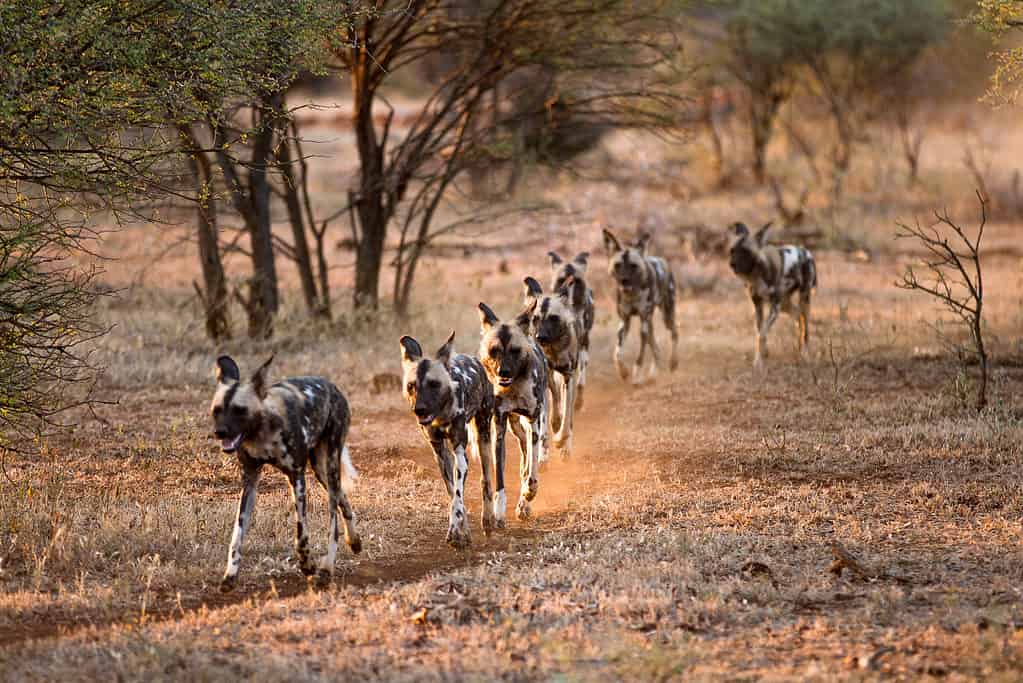
These animals are beautifully patterned with striking, white-tipped tails and unique color patches that are as distinct as individual snowflakes.
©charles Hopkins/Shutterstock.com
Native to sub-Saharan Africa, the African painted dog is an extremely social animal that lives in tight-knit packs. These animals are beautifully patterned with striking, white-tipped tails and unique color patches that are as distinct as individual snowflakes. Although their social structure is comparable to that of wolves, they tend to be gentler towards their pack members. Painted dog packs number between five and 20 individuals, with an alpha pair that leads the pack in both hunting and caring for their young.
African painted dogs often share food and even help pack members that are weak or sick. When it comes to caring for the pups, African painted dogs work together to protect each other’s young. The pack looks out for one another, and both females and males take turns caring for offspring. While some members of the pack hunt, the mother cares for her young. Later, they bring food back to the mom and her pups. African wild dogs have close-knit bonds with their family members, and even sleep cuddled up with their siblings.
6. Emperor Penguins
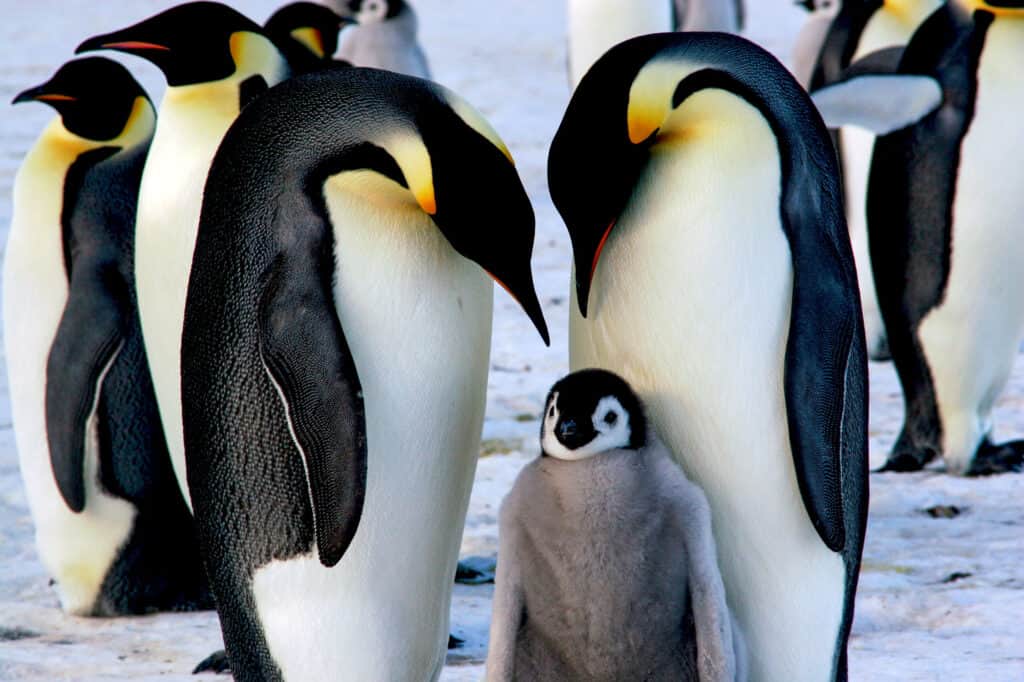
While females might be responsible for laying the eggs, it is actually the males that protect and incubate them.
©iStock.com/BernardBreton
Living in colonies from 500 to even 20,000 pairs, emperor penguins are incredibly social animals who sacrifice much to bravely protect their families. While females might be responsible for laying the eggs, it is actually the males that protect and incubate them. After their eggs are laid, the female penguins go out to hunt for food, leaving the males behind to care for their precious eggs.
Male penguins carefully hold their large egg on top of their feet and incubate it within their brood pouches for around 65 days. Facing temperatures of -58 degrees Fahrenheit, along with icy Antarctic winds up to 120 miles per hour, these males — with their eggs in tow — huddle together in large groups to remain warm despite the harsh winter storms. The large horde of father penguins continually shuffles in small increments, reordering their huddle and taking turns along the chilly outer edges. Once the baby penguin hatches, the father continues to care for it, keeping it warm with its pouch and feeding it a milk-type substance from his esophagus until the mother returns.
7. Lions

Male lions take on the responsibility of protecting their pride’s territory, intimidating any potential intruders.
©Maryke Scheun/Shutterstock.com
Lions live together with other family members in groups called prides. A pride could have as few as two lions, or as many as 40 lions, typically with just a handful of males. The females of the pride are all related, and their daughters tend to stick around even after they mature. Both male and female lions work to protect their families.
Male lions take on the responsibility of protecting their pride’s territory. They intimidate any potential intruders and chase away animals that get too close. Female lionesses hunt together in groups to take down large animals like wildebeest, zebras, and antelopes. They form strong bonds with one another, and even act as communal mothers to all the cubs of the pride, protecting their young and each other. Researchers have even documented several instances in which a younger lioness assisted an older one with missing teeth or a broken jaw — they brought the injured lioness food and cared for her.
Summary of 7 Animals That Bravely Protect Their Families:
All of these different animals are protective of their young and each other. They even come to the aid of the injured, share food, and issue warnings. To be so closely associated, they need a system of communication, and each group has its unique way to reach out to each other.
| Name of Animals | Social Unit Name | Means of Communication |
|---|---|---|
| Elephants | Herd | Vibrations sent through the ground via the trunk. |
| Dolphins | Pod | Whistles for identification and warnings. |
| Orcas | Pod | Complex vocalizations. |
| Wolves | Pack | Howls serve as social rally calls. |
| African Painted Dogs | Pack | Number of sneezes signals messages. |
| Emperor Penguins | Colony | Vocalizations and physical displays. |
| Lions | Pride | Vocalizations (e.g., purrs, growls), licking, and head rubbing. |
The photo featured at the top of this post is © Nick Grobler/Shutterstock.com
Thank you for reading! Have some feedback for us? Contact the AZ Animals editorial team.






